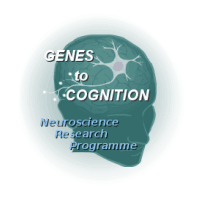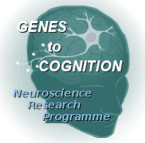G2C::Genes to Cognition
Genes to Cognition (G2C) is a neuroscience research programme with the dual aim of discovering fundamental biological principles and important insights into brain disease.
G2C is an international collaborative program initiated by Professor Seth Grant and supported by the Wellcome Trust following the discovery that multiprotein complexes formed by intracellular proteins and neurotransmitter receptors were important for neuronal plasticity and behaviour.
These protein complexes are microscopic molecular machines inside synapses - the junctions between nerve cells. Molecular proteomic studies show there are more than 1000 synapse proteins working together to process information in the brain.
Multiprotein complexes are involved with dozens of brain diseases, control multiple types of behaviours and are involved with the responses to drug treatments of mental disorders. Evolutionary studies show ancient forms of the complexes evolved over a billion years in single cell animals and may represent the origin of the brain.
Our long term goal is to understand the molecular basis of the extraordinarily complex brain of humans, how this complexity evolved, what it confers on behaviour and why brain evolution made us susceptible to mental illness.
G2C collaborators include scientists with complementary and wide ranging expertise from molecular biologists, computational biologists, electrophysiologists to psychiatrists, together studying the biology of synapses.
The G2C project has a unique database called G2Cdb that houses data resources from our research program.
G2C has an educational program called G2COnline developed in collaboration with the DNA Learning Centre at Cold Spring Harbor Laboratory, USA.
G2C Programme Data Released Online
Genes to Cognition characterised 65 mouse lines with postsynaptic gene mutations using behavioural and electrophysiological phenotyping. Statistical analysis is presented and all raw data are available for download.
Molecular machines, autism and schizophrenia
Professor Seth Grant talks to Norman Swann of ABC Australia at the recent Chicago AAAS meeting.
Brain Science Podcast
Professor Seth Grant gave this weeks Brain Science Podcast, talking about his career and his work on brain synapse evolution.
Human Brain Project Funded
Madness, Genius and the Origin of the Brain
Professor Seth Grant gave the Edinburgh Neuroscience Christmas public lecture addressing fundamental questions such as how did the capacity for thought arise? What goes wrong in mental illness? From an evolutionary perspective. Watch it online.
Evolution of cognitive function
In two papers published in Nature Neuroscience we report genome duplication and diversification events played a key role in the evolution of higher cognitive functions and complex behaviours.
Allen Institute - G2C human brain map in the world press
Broad significance of the Allen Institute for Brain Science - G2C human brain map study has been widely reported around the world.
TNiK and cognitive function
In a paper published in Journal of Neuroscience, led by University of Edinburgh, we report the first in vivo evidence for the role of TNiK, Traf2 and NcK interacting Kinase in synaptic plasticity, neuronal development and specific aspects of higher order cognitive processing.
G2C has moved to Edinburgh
Professor Seth Grant is pleased to announce he and his group has moved to The Division of Clinical Neurosciences, School of Molecular and Clinical Medicine, College of Medicine & Veterinary Medicine, Edinburgh University.
Genetic basis of brain diseases
A set of brain proteins is found to play a role in over 100 brain diseases, providing a new insight into evolution of behaviour. Professor Seth Grant and coworkers have extracted the PSDs from synapses of patients undergoing brain surgery and discovered their molecular components using a proteomics. This revealed that 1461 proteins, each one encoded by a different gene, are found in human synapses. This made it possible, for the first time, to systematically identify the diseases that affect human synapses and provides a new way to study the evolution of the brain and behaviour ...
UnMASCing diseases of the brain
G2C research uncovers proteins underlying devastating brain diseases including: epilepsy, depression, schizophrenia, bipolar disease, mental retardation and neurodegenerative diseases including Alzheimer's and Huntington's diseases.
G2C Online launches
G2C Online launches, in collaboration with Coldspring Harbour Laboratory, a website explaining brain science to students, patients, public.
Switches, circuits, brain and disease
G2C researchers uncover molecular circuits that control behaviour and diseases
G2Cdb Paper Published
The paper describing the aims, use, contents and construction of the Genes to Cognition database, G2Cdb, is now available online from Nucleic Acids Research and will feature in the 2009 Database Issue of NAR. Please view the paper HERE. G2Cdb integrates proteomic, human genetics and neurobiological datasets in a such way that investigators can rapidly query whether a gene or protein is found in brain-signalling complex(es), has a phenotype in rodent models or whether mutations are associated with a human disease. The synapse proteome datasets and integrated views that G2Cdb provides offer a basis for future work in synapse systems biology and represent a significant step forwards in the quest to produce a global view of the role of synapse proteins in physiology and disease. G2Cdb can be freely accessed at http://www.genes2cognition.org/
Origins of the brain
New research has shed light on the evolutionary origins of the brain: it suggests that the big synapse emerged before the big brain
Evolution of NMDA receptor cytoplasmic interaction domains
A recent Genes to Cognition study has brought an evolutionary perspective to bear on NMDA receptor signalling
G2C Programme Phenotyping Battery
We have published online the 20 experimental protocols devised by the G2C Programme that define our neuroscience-specific mouse phenotyping battery. This battery is employed by the team to elucidate the roles of synaptic proteins in experimental paradigms including behaviour, synaptic electrophysiology, neural network physiology, biochemistry and neuroanatomy
G2Cdb Release November 07
G2Cdb integrates human and mouse genomic information with available experimental resources including: synapse proteomics, human gene mutation information in CNS disease, brain gene expression resources, knockout mouse behavioural experiments, and electrophysiological studies of synaptic plasticity, its overall aim being to present an integrated view of the role of synapses in physiology and disease, by focusing on synaptic proteins and diseases of the nervous system, specifically those affecting cognition. The November 07 release of G2Cdb contains data on approximately 2500 mouse and human genes, including: components of the NMDA receptor complex (NRC/MASC); postsynaptic density (PSD) and postsynaptic proteome (PSP) together with details of knockout and transgenic mice with modifications to these genes. The release also incorporates a very significant update to our 2005 paper detailing our systematic curation of the genetic variation literature for NRC/MASC genes, and their association to human disease (Grant et al (2005) PubMed). For we have now collated information on mutations in PSP genes examined for their association(s) to 324 human diseases, of which 91 are nervous system disorders, by literature-mining and expert curation of almost 800 published papers. The database can be searched using the left hand search box present on all the Genes2Cognition web pages, including: http://www.genes2cognition.org/.
Brain Waves: Nerve Cells Talking - And Making Sense
A study published today gives the first global view of how nerve cells build connections and develop networks, key processes in development and the working of the human brain. It outlines the genes that nerve cells need to first start to 'talk' to one another and those required to develop meaningful 'conversations'.
Defining the molecules and processes that build successful networks of nerve cells will help us to understand learning and memory and the ways in which these can fail in brain damage and dementia.
Nerve cells communicate through connections, called synapses, between pairs of cells. The human brain is extraordinarily complex with a network of an estimated 1015 (10,000,000,000,000,000) synapses.
What is poorly understood is how synapses are built during the brain's development, and how the genome programs this. The team looked, for the first time, at the global activity of genes and electrical activity in cultures of nerve cells during these vital developmental stages.
Drs Luis Valor, Paul Charlesworth and Christopher Anderson grew young nerve cells, initially without synapses in culture for three weeks and followed both their growth and their biochemical and genetic activity. They combined two state-of-the-art array technologies - one to examine the genes being expressed, and the other to examine the electrical activity of the nerve cells as they formed a neural network.
"A surprisingly simple picture of the relationship between the genome and the synapse emerged," said Professor Seth Grant, who leads the Genes to Cognition project at the Wellcome Trust Sanger Institute. "There were two waves of gene activity in the developing nerves, the first to control the formation of synapses and a second later wave that was the response of the genome to the synapses electrical functioning".
"We could see the nerves make contact in the cultures, measure their activity and relate that to the changes in the genetic programme."
The first wave of synaptic protein genes emerges over the course of the first few days in culture. This seems to be a genetic program controlling the formation of synapses as the nerve cells grow and touch one another. At this stage there is only a small amount of nerve activity, because the synapses are still forming. About 20% of the genes are recruited into this programme.
Beyond the first few days, the second wave of genes appears. Activity of these genes depends on the nerves actively communicating: the synapse talks back to the genome, telling it what it needs to perform. From this interaction, the network of nerves becomes very active.
"We have combined the study of the activity of nerves with study of the activity of genes to demonstrate that these nerves employ a sophisticated programme to coordinate the formation of synapses and the development of working networks," continued Professor Grant. "The most exciting aspect is that this study not only provides strong evidence for a genetic program used by nerve cells to build synapses but also points toward methods to find the master regulatory genes".
Understanding these processes is important for understanding childhood brain development and also adult disorders such as dementia and stroke. The research of the Genes to Cognition Consortium will continue to reveal the requirements for building a successful synapse and might lead to new ways to stimulate synapse development.
X-linked Genes and Mental Disorders
A new paper published from the G2C group addresses the relationship between neuronal protein complexes and X-linked mental disorders.
The X chromosome is heavily studied in the context of mental disorders. Many forms of mental retardation are linked to genes on the X chromosome, and are grouped under the term X-Linked Mental Retardation. The chromosome has also been linked to autism.
A key protein complex in the mammalian brain is the NMDA Receptor Complex (NRC), which consists of 186 proteins found at glutamatergic synapses. Of the genes encoding NRC members, 7 are found on the X chromosome. All but one have been linked to mental disorders in humans.
The NRC is a component in a much larger structure called the Post-Synaptic Density (PSD). 39 PSD genes are X-linked, and again a high proportion (49%) are involved in mental disorders
The paper reviews the literature to date on these genes, their cellular and physiological functions, and the diseases in which they are known to be involved.
For example, the L1CAM gene encodes the L1 protein, which is involved in cell-cell adhesion. L1 is essential for normal neural development. Mutations, in humans and mice, produce developmental abnormalities. In humans, it is associated with a form of X-linked Mental Retaradation variously called 'X-linked hydrocephalus', 'MASA syndrome', or 'spastic paraplegia type I'.











